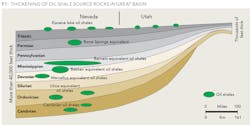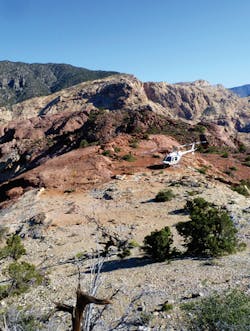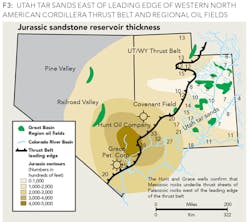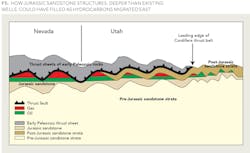THE GREAT BASIN SHALES ARE NOT JUST AS ORGANICALLY RICH AS OTHER SHALES, THEY ARE MANY TIMES THICKER
ALAN K. CHAMBERLAIN, CEDAR STRAT, LAS VEGAS, NEV.
KUMAR BHATLACHARJEE
MOST OF THE GIANT oil fields on earth, elephants, are found in passive margin shelves like the Paleozoic passive margin shelf of the Great Basin of western Utah and eastern Nevada. These shelf Paleozoic sediments thicken from several thousand feet from the Utah Hingeline in central Utah to more than 40,000 feet in central Nevada (Figure 1).
Many age-equivalent North American producing oil shales were deposited in this stratigraphic wedge. However, the Great Basin shales are not just as organically rich as the other shales, but they are many times thicker. The eastern Great Basin, covering 71 million acres, most of which is available for leasing, is the last underexplored onshore basin in North America that likely contains many elephants.
Bakken age-equivalent Mississippian-Devonian Pilot oil shale is up to 900 feet thick in the Great Basin in contrast with only 150 feet or less in parts of North Dakota. One of the favorite stops on Cedar Strat's helicopter-supported field trips is an outcrop of tight Pilot sandstone that bleeds oil when it is freshly broken (opening photo).
Cedar Strat photo
Oil seeps from organic-rich Marcellus age-equivalent Middle Devonian shales in some Nevada outcrops. One well, with gas shows, cut 8,000 feet of Utica age-equivalent Ordovician Vinini shale and was still in Vinini at Total Depth. Oil shales in these Ordovician strata are so organic rich in some outcrops that they have been retorted for oil.
Organic-rich Great Basin Mississippian Antler foreland basin oil shales are measured in thousands of feet in contrast to the age-equivalent Barnett shale that is measured in only hundreds of feet in Texas. Shale thickness from wells and measured sections and shale richness from sample analyses show that the shales have enough organic content to literally generate trillions of barrels of oil (Figure 2).
Some of that oil generated soon after thrust loading in the Late Cretaceous and Early Tertiary. The hydrocarbons then migrated through thousands of feet of subthrust Jurassic sandstone to oil traps along the leading edge of the western North American Cordillera thrust belt in central and northern Nevada and onto the giant folds in the Colorado Plateau of eastern Utah (Figure 3). Subsequent erosion by the Colorado River removed the structural seals allowing most of the hydrocarbons to escape leaving only a residue of 13 billion barrels of oil in the Utah tar sands.
Cedar Strat, using its proprietary geological survey, created a structural contour map on the top of the Mississippian Joana Limestone (Figure 4). This map combines stratigraphic field measurements, geologic mapping, and gravity data to create a structural contour map parallel to the Mississippian shale and the Pilot shale source rocks. Cedar Strat has been creating the geological survey ever since several major oil companies enticed Dr. Alan Chamberlain to leave Placid Oil Company and initiate the first Great Basin geological survey in 1984.
The reason they encouraged Chamberlain to conduct the survey is because the State of Nevada had never authorized a geological survey. Furthermore, much of the mapping of western Utah is nothing more than compilations of student summer field camps. Chamberlain chose to make the contour map on the top of the Joana because the Joana forms a prominent cliff above a strike valley in the Pilot Shale below and a strike valley in the Mississippian Antler basin shales above, which is easily distinguished on surface and subsurface gamma ray logs, and because it is extensively distributed.
The structural contour map literally became a treasure map as it identifies at least 165 untested structures, possibly full of oil and gas, and covering 20 million acres between the Antler Basin oil generating kitchen and the leading edge of the Cordillera thrust belt. As oil migrated from central Nevada to Utah it filled up each fold to spill point before flowing over to the next structure to the east (Figure 5).
Each of the structures could contain a billion or more barrels of oil or oil equivalent. Fortunately, erosion by the Colorado River has exposed thousands of feet of subthrust Jurassic sandstone that forms the cores of mountains in the Las Vegas area.
Cedar Strat typically begins its helicopter-supported field trips in Las Vegas where mountain roots are exposed and then moves northward where only tips of hanging wall thrust duplexes are exposed. Two wells, penetrating thousands of feet of Precambrian and/or Early Paleozoic rocks confirm that subthrust Mesozoic rocks occur below the thrust sheets west of the leading edge of the thrust belt (Figure 3). These evidences suggest that thick subthrust Mesozoic sandstones may also core some, if not many, of the 165 untested structures north of the Colorado River basin.
Not only are the subthrust sandstones the conduit for oil migration but also they are the reservoir rock that has already trapped and produced trillions of cubic feet of gas and hundreds of millions of barrels of oil along the leading edge of the thrust belt (Figure 2).
There is an unprecedented opportunity to acquire almost all the 10-year federal leases on the 165 structures. Information on how the structural contour map was created can be found at AAPG Datapages or by contacting Cedar Strat. Cedar Strat hopes to include the history of oil exploration in the Great Basin and an explanation on how the survey datasets were acquired from which the treasure map was created on its website in the near future.
ABOUT THE AUTHORS
Alan K. Chamberlain, PhD ([email protected]), is president and chief geologist for Cedar Strat Corp. in Las Vegas, Nev. He earned five degrees including a BS, MS, and PhD in geology and has worked for Exxon, Gulf, Marathon and Placid. In 1984 he left Placid to initiate the first Great Basin geological survey.
Kumar Bhattacharjee received a BS in geology from India and an MS in Geophysics as an UNESCO Scholar under the supervision of Dr. King from Utrecht University, Holland. He continued post-grad study under Dr. Milton Dobrin at the University of Houston. He has worked for SONATRACH of Algeria, OGDC of Pakistan, and several consulting companies in Europe. Additionally, he has held positions at Union Texas Petrol Corp. and served as a consultant for ARCO, PDVSA of Venezuela, JAPEX of Japan, and USDOE.








